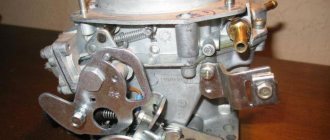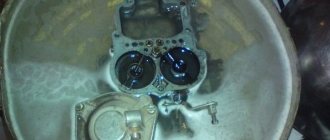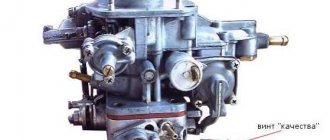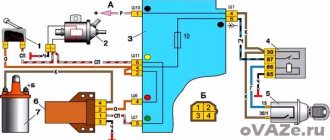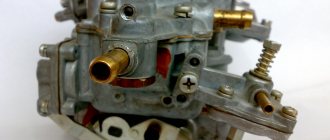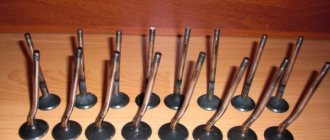The domestic SUV VAZ-2121, also known as the legendary Niva, has been tirelessly traveling around the expanses of our vast homeland and beyond its borders since 1977. Currently, this car not only has not lost its popularity, but on the contrary - the demand of car enthusiasts for this miracle of the automotive industry is only growing every year.
Channel PROGRAMMER'S DIARY
The life of a programmer and interesting reviews of everything. Subscribe so you don't miss new videos.
Why did the Niva become such a popular car? It's simple. The car's high seating position, all-wheel drive, ease of maintenance and relatively cheap prices for spare parts - that's the whole secret. Fishing, hunting, travel, expeditions and even sports racing - all this is the nature of the Niva.
You will be interested: VAZ 2114 - replacing steering tips: which ones are better to install, how to check for malfunctions
Since 1994, serial production of the VAZ-21213 model under the name “Taiga” began.
This VAZ model is equipped with a 1.7-liter carburetor gasoline engine, a five-speed manual transmission, and a contactless ignition system. A Solex 21073 carburetor is installed on the Niva. In the modern world, when progress does not stand still, a carburetor under the hood of a car, and even an SUV, looks sad. When buying a used car, most motorists prefer to choose an injection version rather than a carburetor. And today's youth look at the carburetor in surprise, completely not understanding what it is. But if a person has at least a little understanding of technology, then understanding the essence of the Solex 21073 carburetor will not be a problem. It is enough to familiarize yourself with some information.
The design of the Solex 21073 carburetor on the Niva
You may be interested in: How to specify the path to the game on Steam? Adviсe
This mechanism is a device for mixing the fuel-air mixture. This mechanism is very simplified, unlike the injector. The carburetor consists of only two main parts, one of which is the body and the other is the cover. The carburetor also includes a float chamber, a pump, and an economizer, which is responsible for regulating the fuel supply in order to save it. Inside the housing there are two fuel chambers and diffusers in which a fuel-air mixture is formed. On the carburetor cover there are special fittings for supplying gasoline to the carburetor and studs for attaching the air filter. Also in the cover of the Solex 21073 carburetor there is a needle valve for the float chamber. With the help of these parts the level of fuel consumption is regulated.
You might be interested: What is paintwork in a car? Definition, thickness and features
An air damper is installed inside the carburetor, which mechanically regulates the air supply to the chambers. As you can see, the Solex 21073 carburetor on the Niva has a fairly simple design. With proper care, it will not cause problems for the car owner and will not let him down on the road.
Device
The Solex 21073 carburetor installed on the Niva 1.7 can be classified as an emulsion device.
The mechanism is designed to prepare a working fuel-air mixture. The device consists of two parts - the body and the cover. The device also consists of a float chamber with the ability to balance the level. There is an accelerator pump, an economizer, and an econostat. The design has two fuel chambers and diffusers.
A flammable mixture is prepared in them. The lid has fittings through which gasoline is supplied to the carburetor, and excess fuel goes back into the tank. There are also studs in the lid. They are used to mount the air filter. The lid is also equipped with a needle valve for the float chamber, where the fuel level is directly regulated.
The carburetor has a mechanical air damper. It allows you to start the engine “cold”. In this modification, the Solex 21073 carburetor on the Niva 21213 shows very high efficiency. When properly configured, the device is capable of providing very high technical performance for front-wheel drive vehicles.
Operating principle
As already mentioned, the Solex 21073 carburetor on the 1.7 liter Niva mixes gasoline with air and, as a result, the prepared fuel-air mixture enters the engine, where it burns. The driver starts the engine and closes the choke independently. The fuel pump pumps gasoline into the carburetor's float chamber. The amount of gasoline in this case depends on the position of the needle valve. From the float chamber, gasoline enters the nozzle, and then directly into the mixing chamber. At the same time, both cameras will start working only under heavy load on the engine. For example, if the driver sharply increases the speed by pressing the gas pedal. The engine idle mode is maintained by a solenoid valve. Thanks to this, the engine does not stall and fuel is saved at idle.
Checking and adjusting the idle speed of an engine with a 21073 Solex carburetor
The idle speed system (IAC) is responsible for the operation of an engine with a Solex 21073 carburetor at idle speed (XX). At idle, fuel enters the engine only through it.
Conditions for checking and adjusting idle speed
— The car engine is warmed up to an operating temperature of 80-90º
— The carburetor air damper is completely open (“the choke” is recessed all the way)
— The throttle valves of the first and second chambers are completely closed
— The air filter housing with the filter element is not dismantled
Checking the idle speed of an engine with a 21073 Solex carburetor
The idle speed of an engine with a Solex carburetor 21073-1107010 should be in the range of 750-800 rpm (for a Niva car). Checked using a standard or connected external tachometer. At idle, the engine should run smoothly without interruption. When you sharply press the gas pedal, the engine speed at idle increases without “dips”, and when you release the gas, they decrease without stalling the engine.
If the picture does not correspond to the required one, we adjust the idle speed.
The most basic adjustment of the idle speed of a car engine with a 21073-1107010 Solex carburetor comes down to rotating the screw for adjusting the “amount” of the fuel mixture. Clockwise - the speed increases, counter - decreases. The “quantity” screw with its tip moves the throttle lever of the first chamber and it slightly opens or, conversely, closes the throttle valve. This regulates the amount of fuel mixture entering the engine cylinders (See “The principle of operation of the Solex carburetor idle system”).
Adjusting the idle speed of a car engine with a 21073 Solex carburetor
— Connect the tachometer
or use the standard one in the instrument panel
Connecting the tachometer before adjusting the speed XX
— Start the engine
We press the gas pedal several times, bringing the speed to 2500-3000 rpm before starting the adjustment.
— Use the “quantity” screw to set the minimum stable idle speed
At the same time, the tip of the screw lightly presses the throttle lever and opens it slightly. There should be no vacuum in the tube from the vacuum advance regulator.
— Use the “quality” screw to increase them to the maximum possible value
Using a slotted screwdriver with a thin blade, we rotate the “quality” screw in different directions, achieving the maximum speed of the crankshaft (we use the tachometer as a guide).
When the screw is tightened, the amount of fuel emulsion entering the fuel mixture decreases and it becomes lean; when unscrewed, the fuel mixture, on the contrary, becomes richer.
Initial position of the “quality” screw: 1-1.5 turns from the fully tightened state.
— Use the “quantity” screw to set the speed within 950 rpm
We also focus on the tachometer. We tighten the screw - the throttle valve opens slightly - the speed increases.
— Use the “quality” screw to set the XX speed within 750-800 rpm
Screw it clockwise using a slotted screwdriver.
We check the operation of the engine (see above).
If necessary, repeat the adjustment.
Notes and additions
If the idle speed of an engine with a Solex 21073 carburetor cannot be adjusted, or after adjustment the engine still runs intermittently and stalls, you should pay attention to the following points:
— Correct installation and serviceability of the carburetor solenoid valve
— “Sucking” excess air into the carburetor (ring on the EMC, gasket under the carburetor, etc.)
— Contamination of the idle system
— Correct installation of floats in the carburetor float chamber
— Correct ignition timing setting
— Engine serviceability (valve clearance)
— Serviceability of the ignition system (spark plugs, armored wires, distributor cover, slider, resistor)
You can adjust the idle speed of a car engine by ear, but this requires some experience in car repair and maintenance.
Twokarburators VK - More information on the topic in our VKontakte group, on Facebook Twokarburators FB and on Odnoklassniki - Twokarburators OK
More articles on Solex carburetor 21073-1107010
— Niva 21213, failure when pressing the gas
— Diagram of the idle system and transition systems of the Solex 21073 carburetor
— Design of the idle system of the carburetor 21073 Solex
— Adjusting the throttle valves of the carburetor 21073 Solex
— What do you need to know about the transition systems of the Solex 21073 carburetor?
Car test repair
— Adjusting the idle speed of a car engine with a Solex carburetor 2108, 21081, 21083
Float mechanism
On Niva, the float chamber in the carburetor consists of two sections located on the sides of the chambers for preparing the fuel-air mixture. In general, the float mechanism consists of two floats made of hard rubber, mounted on a special lever, which looms on an axis pressed into the cover of the Solex 21073 carburetor. The essence of the float mechanism is to regulate the fuel supply.
Scheme, principle of operation
When a cold power unit starts up, the starting device starts working first, which is controlled by the driver from inside the car. If the choke handle is fully extended, the air damper in the PC closes completely, and the air damper opens slightly within the set starting gap. This gap can be changed within small limits using an adjusting screw.
The PU is a cavity connected to the intake manifold by a special channel, to a diaphragm, and also through a rod to the air damper. When the driver starts the engine, a vacuum is formed in the intake manifold, which is transmitted to the diaphragm. As a result, the rod pushes the PC air damper, opening it slightly by the amount of the starting gap adjusted by the PU screw.
When the choke handle is pushed back to its original position all the way, the level of starting clearances becomes minimal. In the intermediate position of the choke handle, the starting gaps depend solely on the design of the lever. Note that when the choke handle is pulled out, the throttle valve of the secondary chamber is completely closed through a system of levers. When the accelerator pedal is depressed, the second chamber does not participate in the formation of the fuel-air mixture (FA), so as not to provoke engine failures.
The Solex XX system is designed to supply the engine with fuel assemblies at minimum speed. Gasoline is supplied to the CXX chamber through the main fuel jet, passes through the XX jet, then forms a mixture with air coming from the XX air jet and the diffuser of the first chamber (or rather, its wide part).
Operating principle of the main dosing chamber
During the combustion of the fuel-air mixture in the engine cylinders, air enters the chambers through the air filter. As the air flow increases, pressure is exerted on the nozzles. As a result, fuel rises from the wells into the atomizer. At the same time, air is fed through an air jet from above into the emulsion tube. In the chamber, the fuel is mixed with air and goes into the carburetor channels, where it is directed further into the engine under high pressure. This is the operating principle of almost all Solex carburetors.
Purpose, diagram, structure and principle of operation of the VAZ 2107 carburetor
When setting up the VAZ 2107 carburetor, you need to adjust the starting device yourself. It is designed to confidently start a cold engine. When properly adjusted, the mixture is twice as saturated with fuel as when normally feeding a hot engine.
Let's figure out how the trigger mechanism works. By pulling the choke lever, the driver brings the starting device into a cocked state. The following actions occur:
- The three-arm lever is “cocked” with a cable counterclockwise;
- The telescopic rod is activated;
- The rod turns the air damper.
- The second arm of the lever presses on the throttle valve axis of the first chamber.
- The air flow damper closes completely. The throttle valve of the first chamber is slightly open for starting, creating a starting gap
Turn the choke lever to the closed position. In this position the device is turned on.
To adjust the gap to this range, you need to bend the drive rod on the throttle valve.
Picture 1
Now the rod has pulled the rod along the slot, and as a result the damper opens. Gap “A” should be 5-5.4 mm.
Figure 2
Setting up a VAZ 2107 carburetor with your own hands necessarily includes adjusting the starting device. Let us remind you that it serves to confidently start a cold engine. To do this, the mixture is twice or three times more saturated with fuel than when normally feeding a hot engine.
The starting device for carburetors of the 1107010 family operates at a frequency of 1500 rpm, that is, at the manufacturer’s recommended starting frequency for a cold engine.
We explain the mechanism of action of the starting device. By pulling the “choke”, the driver seems to bring the starting device into a cocked state. Wherein:
- The three-arm lever is “cocked” with a cable counterclockwise;
- Favors telescopic traction;
- The rod, in turn, rotates the air damper through a lever.
- The second arm of the lever presses on the axis of the throttle valve 1 of the chamber.
- The air flow damper is now completely closed, the throttle valve of chamber 1 is slightly open for starting, creating a starting gap
Turn the choke lever until it closes. The device is now “cocked”.
To bring it into this range, the drive rod on the throttle valve is bent.
Now the rod has pulled the rod along the slot, and as a result the damper opens. Gap “A” is 5-5.4 mm.
How to set idle speed on a VAZ 2107
First you need to make sure that the ignition system is configured correctly, all wires are working properly and the engine is completely warmed up.
For this:
- We tighten the mixture “quality” screw to maximum speed (counterclockwise), while the mixture is enriched with fuel;
- By rotating the “quantity” counterclockwise, we set an even higher frequency on our own.
- We carry out a “quality” check: is it possible to increase the speed further?
The meaning of this operation is to increase the “quality” at a constant “quantity” to 850-900 rpm.
You can estimate the speed using an electronic tachometer, or by ear if you are skilled, or using the dashboard tachometer.
The next step is to regulate the air damper drive.
If you do not pay attention to the position of the drive, the machine may stall. To do this, you will need a simple slotted screwdriver and a 7 mm open-end wrench.
The figure shows the position of the damper with the “suction” recessed and extended.
To adjust, do the following:
- the “suction” is recessed;
- We unscrew the rod fixing screw with a slotted screwdriver (the spring pushes it out vertically)
- Tighten the screw;
- We check the valve movement.
Read more: Hyundai Tucson N Line 2021: photo price and characteristics of the new crossover from Hyundai
We adjust the throttle valve drive (“gas”).
If this drive is not configured correctly, the acceleration dynamics and throttle response of the engine deteriorate. This setup must be done with an assistant.
You will need an 8-mm open-end wrench, a screwdriver, a flashlight and a caliper.
We will completely “drown” the “choke” or air damper drive.
- Now your assistant presses the gas pedal all the way to the floor. This opens the throttle valve completely, as shown below; to be sure, you can illuminate the first chamber with a flashlight. After releasing the pedal, the damper should completely close the first chamber without gaps.
To adjust, use a caliper to measure the length of the rod; it should be exactly 8 cm. By rotating the tips, we “adjust” the length of the rod to this size by unscrewing the “locking” nuts.
After this, we put the rod in place and repeat the test. Modern rods are often made of very poor plastic, which shrinks. Therefore, you need to check the “break-in” of the traction after a week or two.
You may not know how to adjust the carburetor of a VAZ 2107, but anyone can set the length of the rod.
We have considered only a few possibilities for adjusting the carburetor with our own hands. In general, there is an entire profession called “carburetor mechanic,” which implies full mastery of this necessary and complex technology. It is simply impossible to describe all the nuances of this process in one article. But we hope that the basic principles were clear and useful to you.
The “seven” was equipped with various modifications of the DAAZ 2107 carburetor (Dimitrovgrad Automobile Unit Plant). They are all similar in principle and differ only in some design details.
Diagram of the VAZ 2107 carburetor structure: (1 - screw for adjusting the stroke of the accelerator pump intake valve; 2 - carburetor cover; 3 - fuel jet of the transition system of the second chamber; 4 - air jet of the transition system; 5 - air jet of the econostat; 6 - fuel jet of the econostat; 7 — main air jet of the second chamber; 8 — emulsion jet of the econostat; 9 — pneumatic drive of the throttle valve of the second chamber; 10 — small diffuser; 11 — jets; 12 — discharge valve of the accelerator pump; 13 — accelerator pump nozzle; 14 — air damper; 15 - main air jet of the first chamber; 16 - starting device jet; 17 - automatic starting device; 18 - idle air jet; 19 - idle fuel jet; 20 - fuel supply needle valve; 21 - fuel filter; 22 - fuel supply fitting ; 23 — float; 24 — screw for factory adjustment of the idle speed system; 25 — main fuel jet of the first chamber; 26 — adjusting screw for the quality of the working mixture;
27- adjusting screw for the amount of carburetor working mixture 2107-1107010; 28 — throttle valve of the first chamber; 29 — carburetor body; 30 — throttle valve of the second chamber; 31 — throttle body; 32 - emulsion tube; 33 — main fuel jet of the second chamber; 34 — accelerator pump bypass jet; 35 — accelerator pump inlet valve: 36 — accelerator pump drive lever; 37 - carburetor pneumatic valve 2140-1107010-70.) Purpose.
The purpose of the carburetor is to prepare the gasoline-air mixture in the required proportion and supply it to the engine cylinders. The quality of engine operation, power output, and service life depend on how correctly the ratio between fuel and air is maintained, and how well the dispersion is mixed.
Design and principle of operation. The schematic diagram of the VAZ carburetor is conventionally divided into three structural elements:
- Cover with outlets for hoses; The structure of the VAZ 2107 carburetor cover: (1 - float axis; 2 - needle valve; 3 - float; 4 - gasket; 5 - trigger diaphragm with rod; 6 - spring; 7 - adjusting screw; 8 - trigger cover; 9 - idle fuel jet; 10 — solenoid shut-off valve; 11 — plug; 12 — carburetor cover; 13 — fuel filter; 14 — air damper; 15 — fuel supply pipe; 16 — air damper axis with lever; 17 — control lever fixation ball air damper; 18 — air damper control lever; 19 — lever axis; 20 — bushing for fastening the air damper drive rod)
- The housing in which the float chamber and chambers with diffusers are located; Structure of the VAZ 2107 carburetor body: (1 - accelerator pump diaphragm; 2 - accelerator pump drive lever; 3 - cover; 4 - accelerator pump drive cam; 5 - power mode economizer cover; 6 - economizer diaphragm; 7 - economizer fuel nozzle; 8 — economizer valve; 9 — check valve of the accelerator pump; 10 — accelerator pump nozzles with a fuel supply valve; 11 — nozzles; 12 — main air jets with emulsion tubes; 13 — main fuel jets; 14 — bracket for fastening the air damper drive rod shell; 15 — adjusting screw of the second chamber; 16 — stopper of the adjusting screw; 17 — stopper cap; 18 — adjusting screw for slightly opening the throttle valve of the first chamber; 19 — axis of the throttle valve of the first chamber with drive levers; 20 — locking lever of the second chamber; 21 — lever spring locks; 22 — throttle axis of the second chamber with a lever; 23 — throttle valve of the first chamber; 24 — throttle valve of the second chamber; 25 — plug for adjusting screw of mixture quality (composition); 26 — return spring of the throttle valve drive lever of the second chamber; 27 — adjusting screw for the quality (composition) of the idle mixture; 28 — carburetor body; 29 — adjusting screw for the amount of idle mixture; 30 - electrical wire of the limit switch of the forced idle economizer; 31 - carburetor heating unit)
- The bottom where the throttle valves are located.
Diagnostics of malfunctions of the Solex 21073 carburetor on a Niva
Any mechanism is subject to physical wear and tear during its operation. Likewise, the Solex 21073 carburetor on the Niva requires periodic inspection and maintenance. If any malfunction is detected, it is first necessary to carry out diagnostics. The causes of carburetor malfunction can be different. This includes refueling with low-quality gasoline and a dirty air filter. As a result, small particles of dirt enter the carburetor chamber. This results in problems in the system in the form of increased fuel consumption and poor operation of the mechanism as a whole. There is no need to rush to replace the carburetor with a new one. Simple cleaning and adjustment will help eliminate these symptoms.
How to restore carburetor operation?
To clean or adjust the Solex 21073 carburetor on the Niva, it must be removed. We remove the air filter housing and remove all the tubes and wires that interfere with getting the mechanism to the surface. Unscrew the nuts and remove the carburetor.
It is best to disassemble it on a table in a well-lit and ventilated area. There are many small parts in the carburetor, therefore, in order not to get confused about what and where, it is recommended to put all the parts in order. You may have to purchase a Solex 21073 carburetor repair kit for the Niva at an auto parts store. It will help you quickly fix the breakdown, and besides, it is inexpensive. Wash the carburetor with special means or regular gasoline.
Adjusting the Solex 21073 carburetor on a Niva
Adjust the carburetor on site after washing and installing it. At the bottom of the Solex 21073 carburetor there is a screw that controls the fuel supply level. Using a flat-head screwdriver, turn this screw until it stops with the engine off. Then unscrew the screw five turns back and start the engine. Next, the screw must be tightened and unscrewed until engine operation becomes uniform. After the engine speed is normalized within 900, the screw is set one turn all the way.
